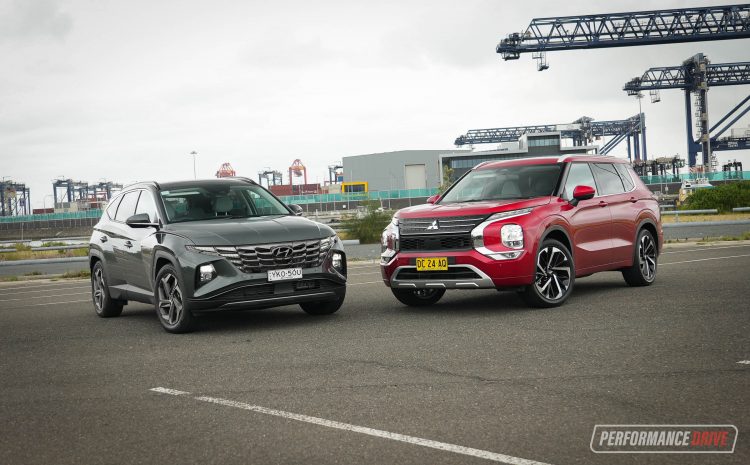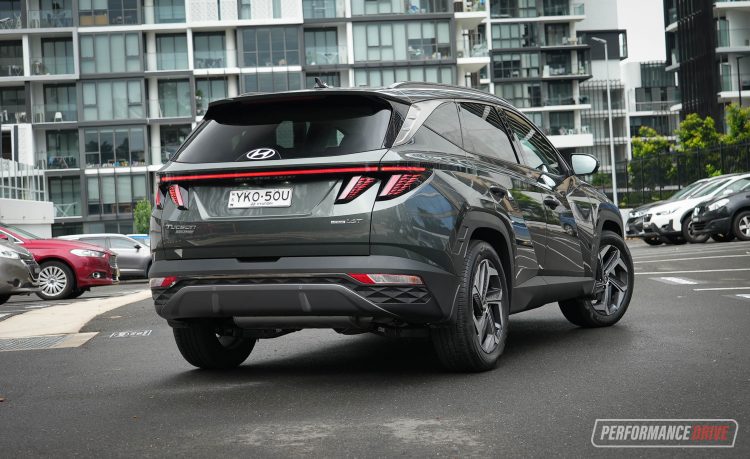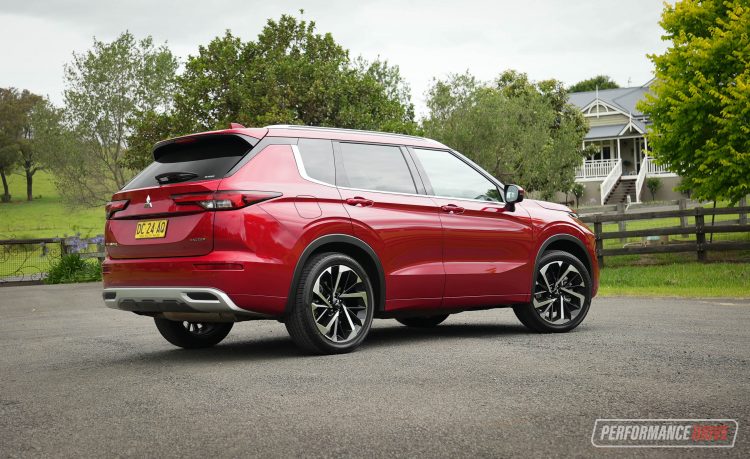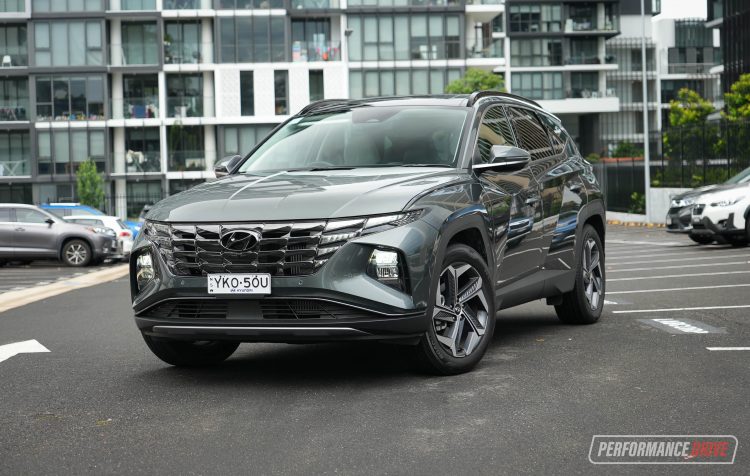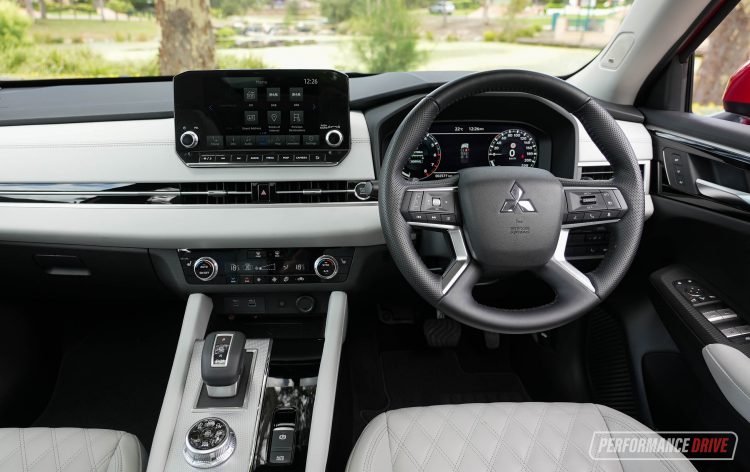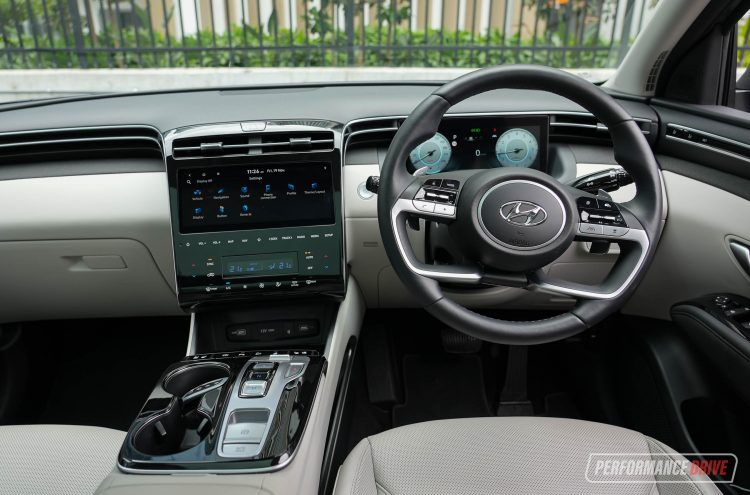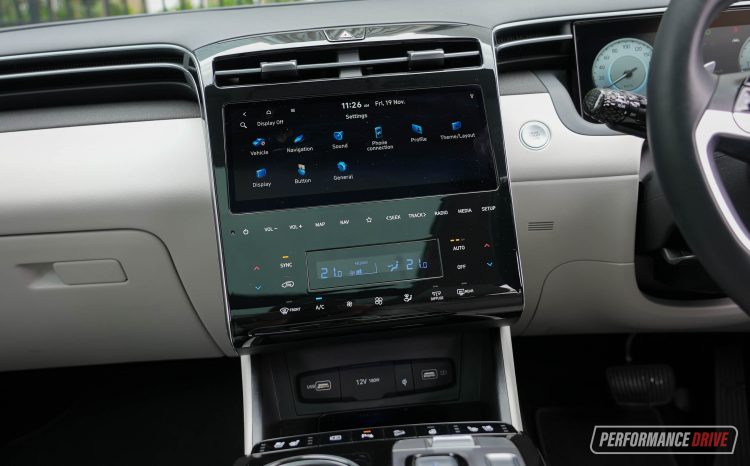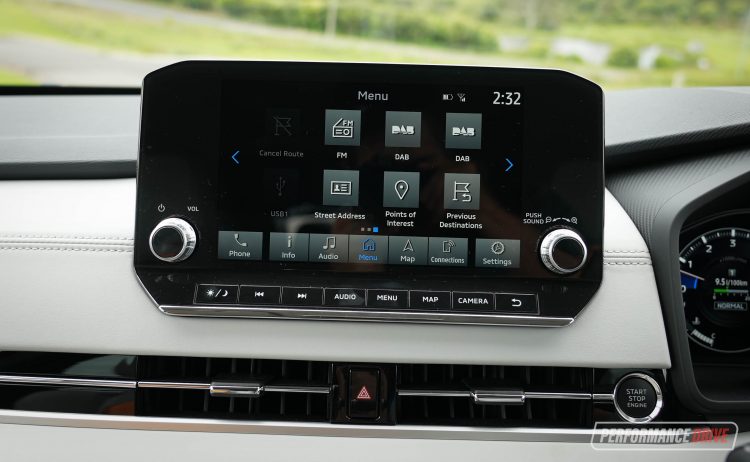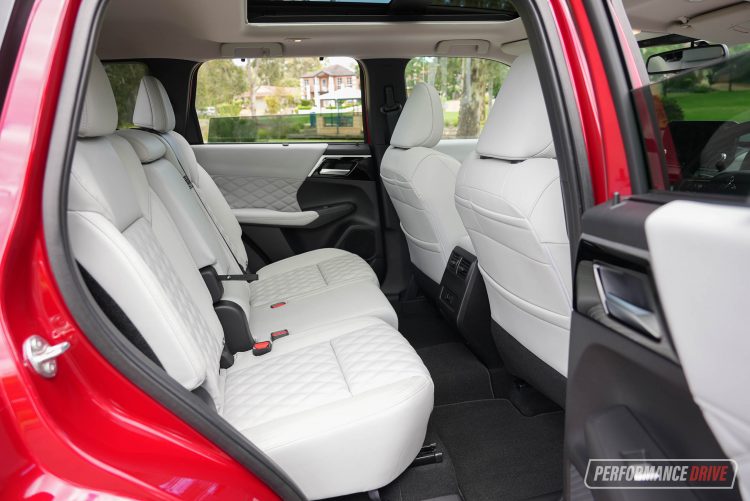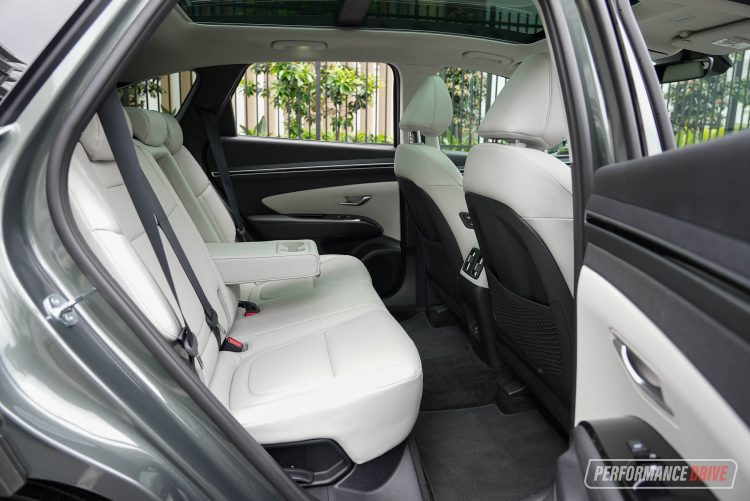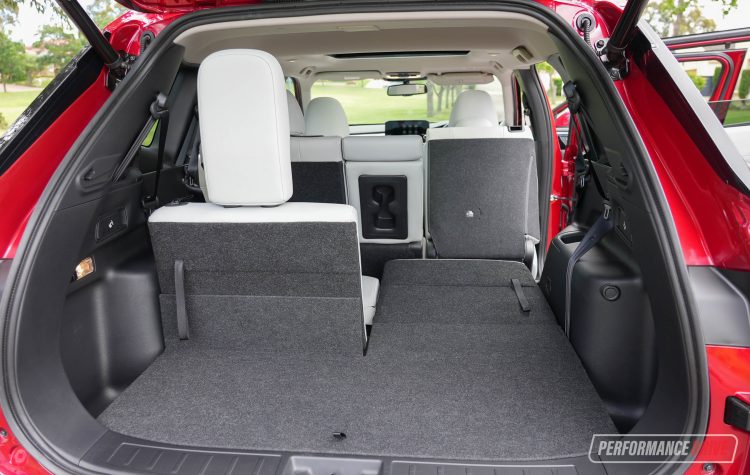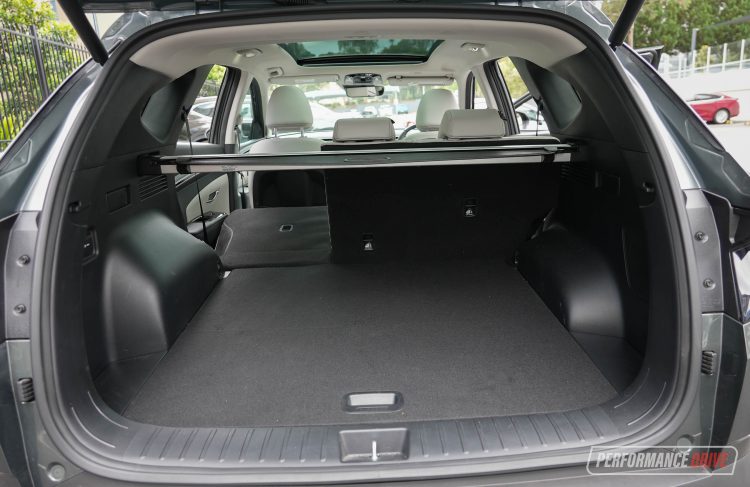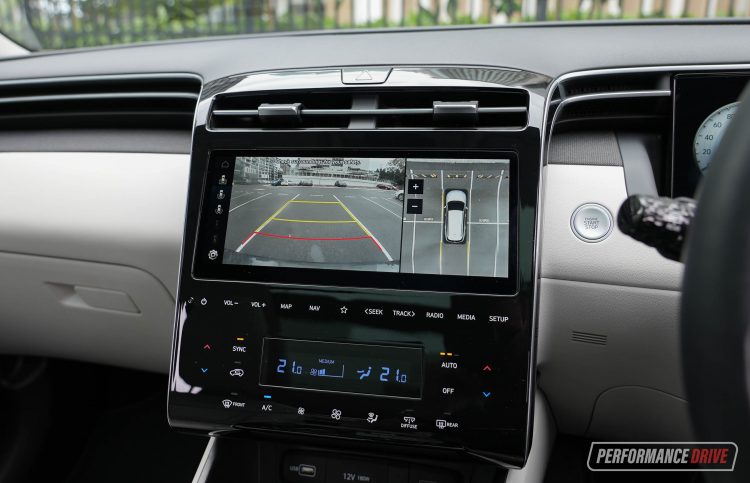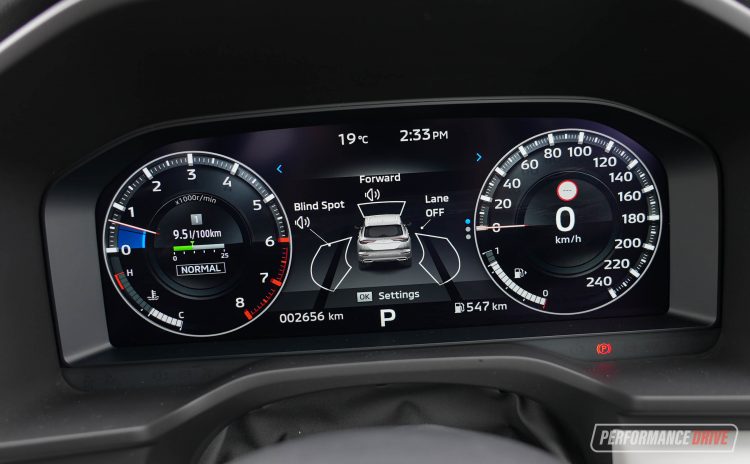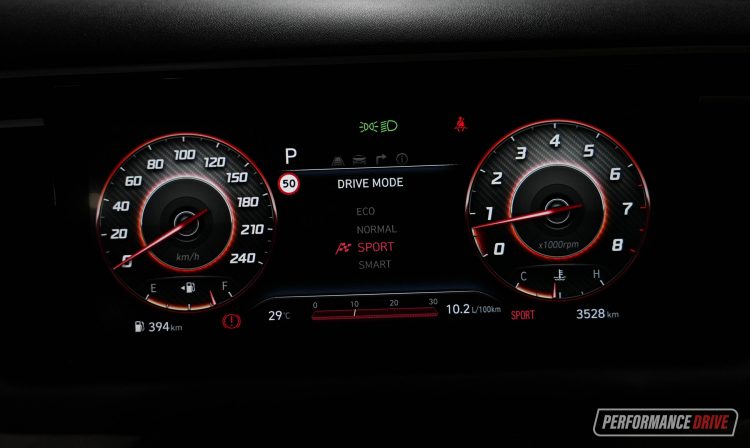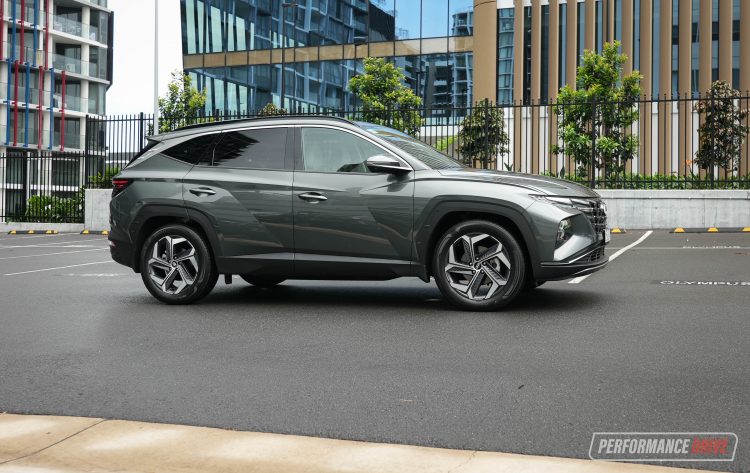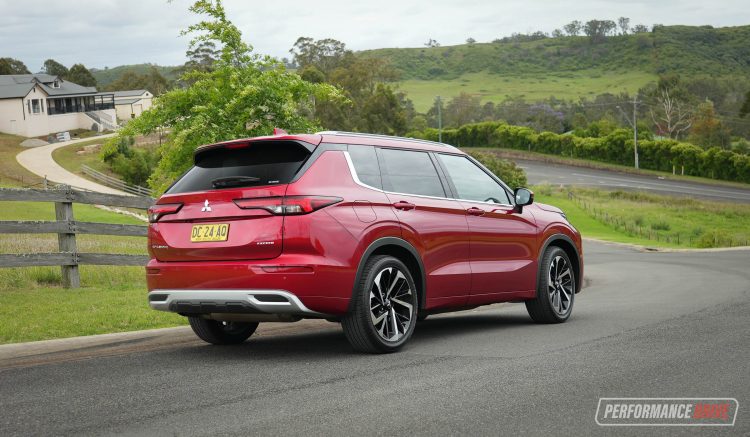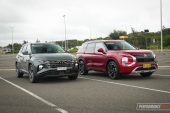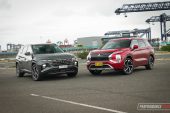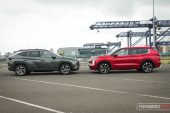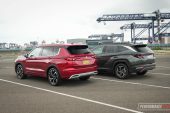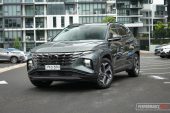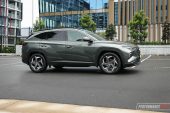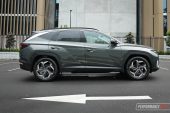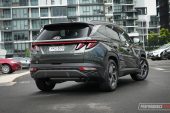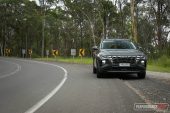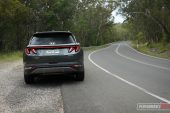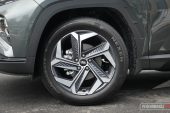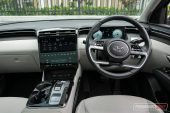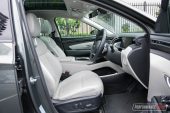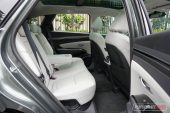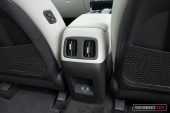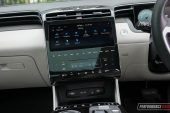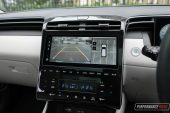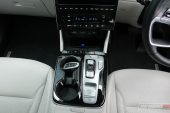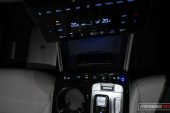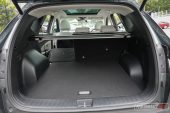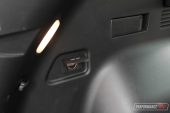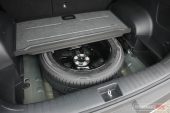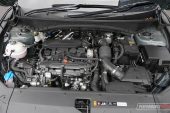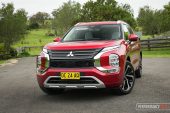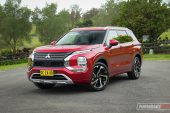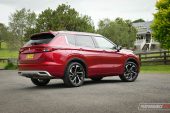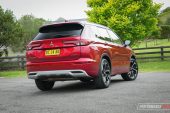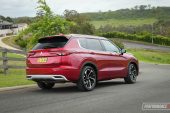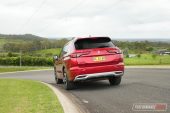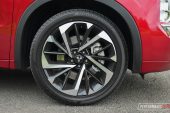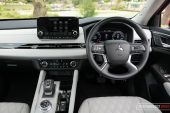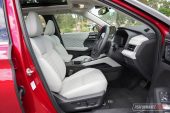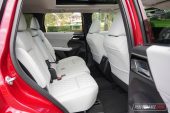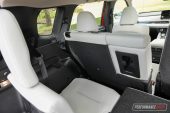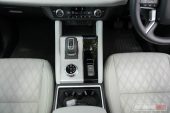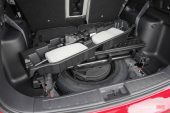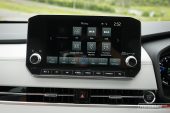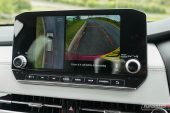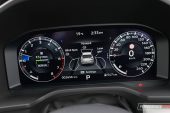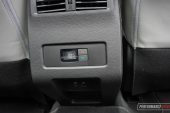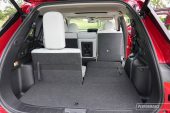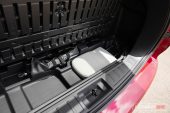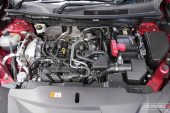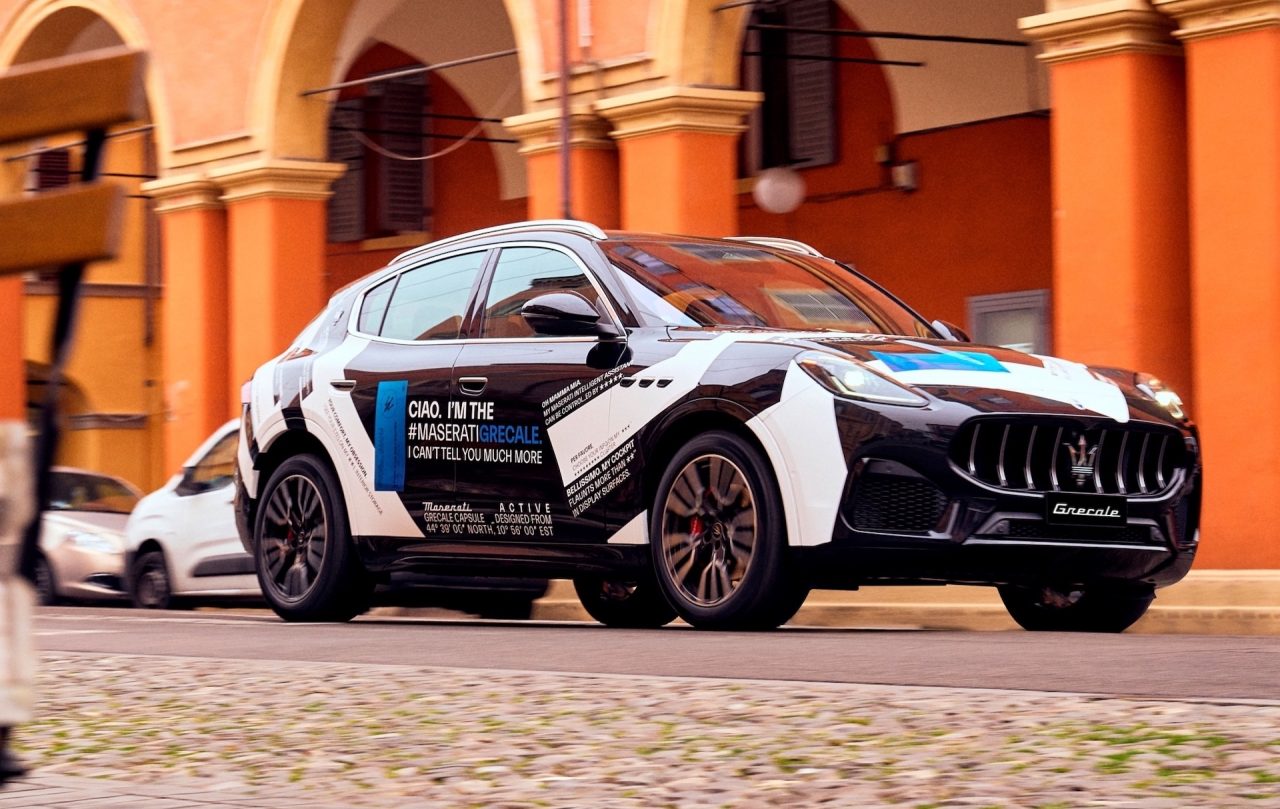If you are in the market for an upper middle-sized SUV for your next purchase, the 2022 Mitsubishi Outlander and Hyundai Tucson have probably come across your view. It’s easy to become overwhelmed with choice in this market segment, as it is one of the most crowded. So, we thought we’d put the popular Outlander and Tucson side-by-side for a comparison review.
Both SUVs have fresh models on offer among their generation lifecycles, so they should be similar in features and safety tech. They also retail for similar prices. Here, we’ll compare the top-spec of each. The Outlander Exceed, which start from $47,990, and the Tucson Highlander, which retails from $50,400 (excluding on-road costs).
2022 Hyundai Tucson Highlander 1.6T – THE SPECS
[column width=”47%” padding=”6%”]Engine: 1.6-litre turbo-petrol four-cylinder
Output: 132kW@5500rpm / 265Nm@1500-4500rpm
Transmission: Seven-speed dual-clutch auto
Drive type: All-wheel drive
Wheels: F & R: 19×7.5, 235/55
ANCAP: Five stars
Tare weight: 1656kg
Power-to-weight: 12.54:1 (kg:kW)
Official fuel economy: 7.2L/100km
Economy during test: 8.2L/100km[/column] [column width=”47%” padding=”0″]Fuel capacity/Type: 54L/91 RON
Power efficiency: 18.33kW:L/100km
0-60km/h: 5.06 seconds*
0-100km/h: 10.46 seconds*
60-110km/h: 7.22 seconds*
1/4 mile: 17.64 seconds at 132.6km/h*
Max acceleration: 0.555g
100-0km/h braking: 3.16 seconds at 39.64 metres*
Max deceleration: -1.109g
Decibel at idle: 36*
Peak decibel at 60-100km/h: 77*
Priced from: $50,400[/column][end_columns]
2022 Mitsubishi Outlander Exceed – THE SPECS
[column width=”47%” padding=”6%”]Engine: 2.5-litre four-cylinder
Output: 135kW@6000rpm / 245Nm@3600rpm
Transmission: CVT auto
Drive type: All-wheel drive
Wheels: F: 20×8.0, 255/45
ANCAP: Five stars
Tare weight: 1725kg
Power-to-weight: 12.77:1 (kg:kW)
Official fuel economy: 8.1L/100km
Economy during test: 7.8L/100km
Fuel capacity/Type: 55L/91 RON[/column] [column width=”47%” padding=”0″]Power efficiency: 16.66kW:L/100km
0-60km/h: 4.79 seconds*
0-100km/h: 10.10 seconds*
60-110km/h: 7.08 seconds*
1/4 mile: 17.36 seconds at 135.3km/h*
Max acceleration: 0.492g
100-0km/h braking: 3.24 seconds at 41.91 metres*
Max deceleration: -1.025g
Decibel at idle: 40*
Peak decibel at 60-100km/h: 83*
Priced from: $47,990[/column][end_columns]
* Figures as tested by PerformanceDrive on the day. Factory claims may be different
2022 Hyundai Tucson vs Mitsubishi Outlander – THE PACKAGE
Firstly, both SUVs have made huge leaps in external design. The previous Outlander was tired and long overdue. Mitsubishi has gone with a futuristic, big, and bold design that resembles elements of Land Rover at the front. You are instantly captivated by the high-waisted and bulged front end with headlights that sit high. The bonnet sits tall and confident, embellished by large chrome sections and a prominent glossy black grille.
The mid-section is a little more understated and almost disproportionate compared with the front. You’ll notice the bonnet line sits much taller than the door line. There are subtle contours that flow to the rear. At the rear, the design resembles more the previous generation with its wide and linear taillights. It is less bulged than the front end – almost like two different cars, front to rear.
The Tucson takes on an alternative design with a sharper, slimmer, less puffed-up look. At the front, a new ‘parametric’ front grille looks striking. It captures light in a unique way and reflects it to make a cool pattern. We love how the outer sections of the grille merge with the first column of LED lights. The rear is also eye-catching with jagged LED taillights that bridge together across the width of the car. Very Audi-like.
Those parametric patterns seen at the front are also mirrored on the lower rear bumper. It gives off a vibe of attention to detail and high quality. You also notice a tad of minimalism with the way the rear wiper conceals into the spoiler when not in use. Good looks are always subjective, but we think the Tucson’s external design has a more flowing and consistent theme than the Outlander’s.
In terms of dimensions, the Outlander is 80mm longer and 80mm taller than the Tucson, giving that extra space needed for third row seating that the Tucson doesn’t offer. It also has more front and rear overhang. But the Tucson is 3mm wider and has a 49mm larger wheelbase. All of which might explain the Outlander’s heavier appearance, and the Tucson’s more planted look.
Turning to the interior, and the Tucson parades itself elegantly for this segment, pushing the boundaries. Presentation and practicality are both spot on. Our example Highlander had a dual-tone cream and grey colour scheme, which presented stylishly against some brushed chrome on the seat backs and door handles. A minimalist theme comes out with the way the air vents blend into the design and shapes of the dash. Everything is well lit up at night thanks to LED lighting, and you can customise the ambient lighting colours too.
In the Outlander, the interior feels a tad more inferior as it has more hard plastics than the Tucson. Our test model also had a dual cream and grey arrangement, but it was more obvious that it was a base model wrapped with a couple of extra overlays. For example, you get beautifully quilted leather wraps over parts of the doors, but they sit over the top of hard plastics underneath. But the matching quilted patterns on the seats, the diamond-cut look knobs, and the air vents that integrate into the flow of the dash all look dazzling. The door-close has a positive thud in the Outlander, too. The Tucson’s doors sound clunky and cheap.
The buttons on the centre console of the Tucson are touch buttons with no physical clicking, and they look and feel super-elegant. The layout is symmetrical and uncluttered, which makes the environment feel clean, neat, and easy to navigate. It also helps that there are gear buttons instead of a gearstick. Both SUVs offer huge and plenty of storage areas, including a large area in front of the gear selector buttons or gear shifter, drive tunnel lower shelves on both sides, large door pockets and bottle holders, and a big centre console. New tri-sectioned back of front seat pockets in the Outlander’s second row are a nifty addition from Mitsubishi.
A stand-out in the Tucson is the beautifully presented, high resolution and responsive centre touch-screen and digital instrument cluster. Both screens look gorgeous and are easy to read with their minimalist layouts. On the other hand, the Outlander’s on-screen menus lack style. They have a blocky font, and just don’t come close to the visual appeal of the Tucson’s. Though, the Outlander’s digital instrument cluster is larger than the Tucson’s. But we prefer how the Tucson’s centre screen sits in the dash in a flatter, more integrated fashion. The Outlander’s screen sits perched high on top of the dash.
No matter where you sit in both SUVs, you’ll be surprised with how much wriggle room you have. In the front and second rows, legroom and headroom are aplenty. The obvious advantage with the Outlander is extra two seats. But legroom here is very minimal, and probably only appropriate for kids or short trips. Thankfully, the Outlander’s second row on is on rails, which allows you to adjust the space where you need it most. However, the second row doesn’t fold flat like in the Tucson. And finally, the Outlander now comes with rear air vents and rear air-conditioning temperature controls.
Even though the Outlander is the longer SUV, boot space is officially larger in the Tucson. With the second row in use, the Outlander fits 478 litres of cargo, and the Tucson fits 539 litres. When the second row is folded down, space is still larger in the Tucson, at 1860 litres versus 1461 litres. Both vehicles use the same VDA measuring standards.
Across the two SUVs there are many features previously seen in luxury cars only. Both SUVs score key safety features like blind-spot sensors, forward and reverse collision mitigation with pedestrian avoidance, rear cross-traffic alert, distance-controlled cruise control, auto high beam, lane departure warning with passive steer assistance, active lane-keeping aid, road-sign recognition, and front and rear parking sensors.
Both SUVs are also fitted with LED lights all-round, leather-appointed interior and seats, heated front seats, brilliant premium audio systems with Android Auto and Apple CarPlay, sat-nav, front, rear and side-view cameras, wireless phone charging capability, ambient interior lighting, many USB ports, panoramic sunroofs with electric tilt and slide openings, and powered tailgates, just to name a few.
The Outlander exceeds (excuse the pun) the Tucson by offering active cornering headlamps with active-shadowing high beam, auto dipping side mirrors when reversing, a head-up information display, rear window pull-up sunshades, and wireless Apple CarPlay (oddly, the Tucson only comes with wireless Android Auto and Apple CarPlay in lower spec models fitted with the smaller multimedia screen).
On the other hand, the Tucson offers items the Outlander doesn’t. Like side-view lane changing cameras in the instrument cluster, front cross traffic alert, side door exit warning, ventilated front seats, heated rear seats, a heated steering wheel, front sun visor extensions, secondary front passenger seat adjustment buttons on the driver’s side, remote engine start, tyre pressure sensors, and a full-size alloy spare wheel (space-saver in the Outlander). The reversing camera also produces a higher quality picture too. In the Outlander, it can’t pick up the image after dark at all, and the location of the camera doesn’t offer a good measure of distance or position.
Hyundai offers a fantastic five-year, unlimited kilometre warranty, 12 months of free road-side assistance, and capped-price servicing. If you service the Outlander at a Mitsubishi dealership, warranty extends to 10 years or 200,000km. 12 months of free road-side assistance and capped-price servicing are also offered. Servicing is required every 12 months or 15,000km on both the Outlander and the Tucson.
2022 Hyundai Tucson vs Mitsubishi Outlander – THE DRIVE
As engines get smaller, the Mitsubishi Outlander’s petrol engine gets bigger. With the lack of a turbo, it needs to pull together all it has to produce 135kW at a high 6000rpm. It also spins up 235Nm of peak torque at 3600rpm. It’s not the most thrilling engine, but it gets up to speed quickly. We timed 0-100km/h in 10.10 seconds. Being paired to a CVT auto transmission makes the engine feel and sound thrashy and breathless when driven enthusiastically. But for your everyday commute, it doesn’t have any trouble keeping up with the flow of city traffic.
Even though Tucson’s 1.6-litre petrol engine is smaller than the Outlander’s, it feels livelier and more comfortable to be pushed. You can especially feel the difference in the two engines on hills as the Tucson feels like it has more legs. It performs well on low and medium acceleration as it pulls away with confidence, feeling like there’s lots more to come. But when full acceleration is applied, you quickly notice there’s no more give. It feels like full throttle achieves the same as medium throttle. We know it could do better, as the same engine with a different tune offers 150kW of power in other Hyundai models. Why can’t the Tucson have this tune too? It has 3kW less power than the Outlander, but 20Nm more torque from a low 1500rpm, thanks to a turbo boost. Our testing revealed a 0-100km/h time of 10.46 seconds.
We must mention that the Tucson has an unforgivable acceleration jerkiness from the dual-clutch gearbox. There seems to be never enough acceleration on take-off. Naturally, you apply more acceleration, and then there’s suddenly too much for the job. There is no happy medium. We spun tyres a few times unintentionally. It also has a trait where it gets bogged down in the wrong gear when slowing to a corner, then time is wasted when accelerating again as it scrambles to find the optimum ratio. With a better-sorted gearbox we think it would produce a quicker 0-100km/h time as well.
The all-important fuel consumption for both SUVs reveals a mixed bag of results. Given the significantly smaller engine displacement in the Tucson, it rates a better official average of 7.2L/100km. The Outlander’s is 8.1L/100km. But during our testing on a mix of city and highway driving, the Tucson scored 8.2L/100km; a tad more than the Outlander’s 7.8L/100km in almost identical conditions. Either way, considering the power outputs you get, there is room for improvement for both SUVs. At least they can both run on the lowest 91RON fuel.
On the road, the Outlander feels quite soft. The suspension excels to cushion and silence smaller bumps, but it struggles over deeper ones. This causes it’s track to feel flimsier than the Tucson at highway speeds. It dances around in the lane more, whereas the Tucson holds parallel with less intervention required. Though, the Outlander has some excellent grip from the 20-inch wheels and fat 255 tyres (235s on the Tucson). Much effort rests on decent grip to get the job done. The Tucson also feels sturdier and stronger to handle big bumps, perhaps thanks to its larger wheelbase and its Aussie tune. Hyundai performs dynamics tuning locally in Australia for vehicles sold here, and it seems to pay off in the Tucson.
Mitsubishi markets the new Outlander to be fit those who want off-road adventures. For starters, there are more off-road modes than in the Tucson. But it doesn’t necessarily mean that it is more capable off road. That soft suspension makes the cabin comfortable when tackling dirt roads and corrugations. But it bottoms out easier than the Tucson over big ditches and wheel ruts – especially if you have extra weight on board. It’s no serious off-roader, particularly with those 20-inch lower profile tyres. But having four-wheel drive, and that bit of extra ground clearance (29mm more than the Tucson), makes any soft-roading duty a breeze.
Both the Tucson and Outlander have mediocre towing capacities, at 1650kg and 1600kg braked, respectively. If you have frequent needs to tow, there are more suitable SUVs to choose from.
2022 Hyundai Tucson vs Mitsubishi Outlander – THE VIDEO
2022 Hyundai Tucson vs Mitsubishi Outlander – THE VERDICT
It’s never a straightforward answer to advise which is the best of two vehicles. It ultimately depends on what your must-haves are and what your nice-to-haves are. If you need more than five seats, the Outlander would be the answer very quickly. If price is key and long-term peace of mind, the Outlander will also rule. But the Tucson feels more thought out with a classier internal and external design, more tasteful menu layouts, and more features than the Outlander.
Both SUVs have room for improvement with their drivetrains in terms of power, fuel consumption and gearboxes. But they both hit the mark on interior practicality, technology and space. If it were our money going on one of these we’d take the Hyundai.
[column width=”47%” padding=”6%”]Better on the Hyundai Tucson
– Classier, more consistent external design
– Interior looks and feels more elegant, especially the on-screen menus
– On-road dynamics
– A smidge more features and safety tech, including a full-sized spare alloy
– Engine feels more willing and torquier up hills
[/column] [column width=”47%” padding=”0″]Better on the Mitsubishi Outlander
– Third row seating
– Lower cost
– 10-year warranty
– CVT is smoother than the jerky DCT in the Tucson[/column][end_columns]
As always, if you’re thinking about buying a new car don’t forget to click here to speak with our car buying specialists.
